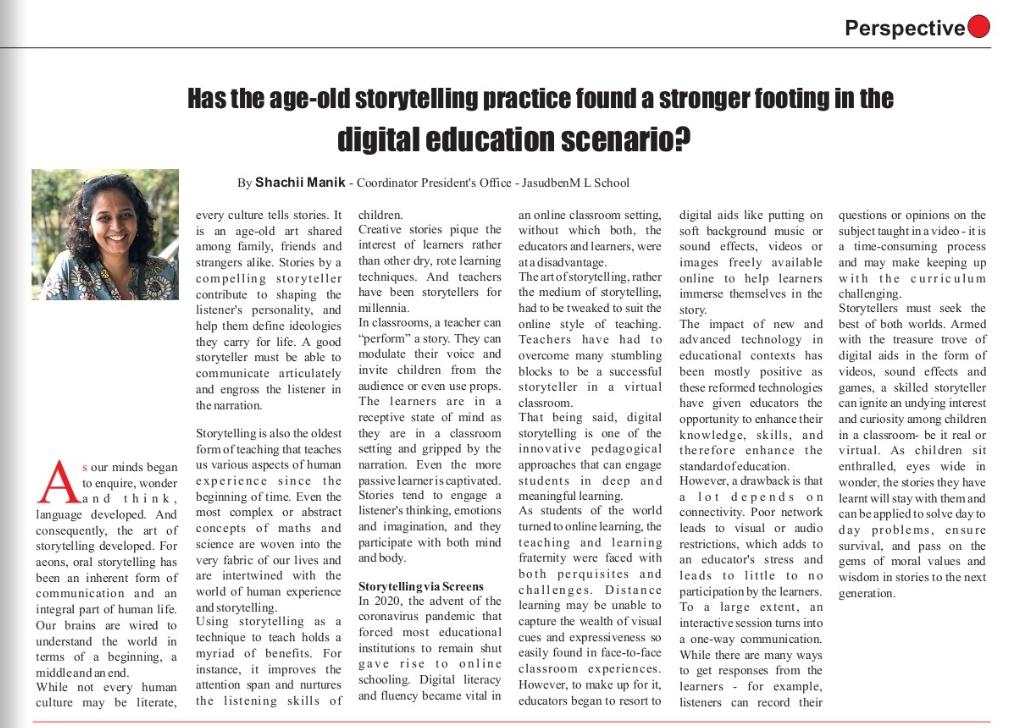Authored article inputs with Shachii Manik – Coordinator President’s Office – Jasudben M. L. School
As our minds began to enquire, wonder and think, language developed. And consequently, the art of storytelling developed. For aeons, oral storytelling has been an inherent form of communication and an integral part of human life. Our brains are wired to understand the world in terms of a beginning, a middle and an end.
While not every human culture may be literate, every culture tells stories. It is an age-old art shared among family, friends and strangers alike. Stories by a compelling storyteller contribute to shaping the listener’s personality, and help them define ideologies they carry for life. A good storyteller must be able to communicate articulately and engross the listener in the narration.
Storytelling is also the oldest form of teaching that teaches us various aspects of human experience since the beginning of time. Even the most complex or abstract concepts of maths and science are woven into the very fabric of our lives and are intertwined with the world of human experience and storytelling.
Using storytelling as a technique to teach holds a myriad of benefits. For instance, it improves the attention span and nurtures the listening skills of children.
Creative stories pique the interest of learners rather than other dry, rote learning techniques. And teachers have been storytellers for millennia.
In classrooms, a teacher can “perform” a story. They can modulate their voice and invite children from the audience or even use props. The learners are in a receptive state of mind as they are in a classroom setting and gripped by the narration. Even the more passive learner is captivated.
Stories tend to engage a listener’s thinking, emotions and imagination, and they participate with both mind and body.
Storytelling via Screens
In 2020, the advent of the coronavirus pandemic that forced most educational institutions to remain shut gave rise to online schooling. Digital literacy and fluency became vital in an online classroom setting, without which both, the educators and learners, were at a disadvantage.
The art of storytelling, rather the medium of storytelling, had to be tweaked to suit the online style of teaching. Teachers have had to overcome many stumbling blocks to be a successful storyteller in a virtual classroom.
That being said, digital storytelling is one of the innovative pedagogical approaches that can engage students in deep and meaningful learning.
As students of the world turned to online learning, the teaching and learning fraternity were faced with both perquisites and challenges. Distance learning may be unable to capture the wealth of visual cues and expressiveness so easily found in face-to-face classroom experiences. However, to make up for it, educators began to resort to digital aids like putting on soft background music or sound effects, videos or images freely available online to help learners immerse themselves in the story.
The impact of new and advanced technology in educational contexts has been mostly positive as these reformed technologies have given educators the opportunity to enhance their knowledge, skills, and therefore enhance the standard of education.
However, a drawback is that a lot depends on connectivity. Poor network leads to visual or audio restrictions, which adds to an educator’s stress and leads to little to no participation by the learners. To a large extent, an interactive session turns into a one-way communication. While there are many ways to get responses from the learners – for example, listeners can record their questions or opinions on the subject taught in a video – it is a time-consuming process and may make keeping up with the curriculum challenging.
Storytellers must seek the best of both worlds. Armed with the treasure trove of digital aids in the form of videos, sound effects and games, a skilled storyteller can ignite an undying interest and curiosity among children in a classroom- be it real or virtual. As children sit enthralled, eyes wide in wonder, the stories they have learnt will stay with them and can be applied to solve day to day problems, ensure survival, and pass on the gems of moral values and wisdom in stories to the next generation.
This article appeared in the June 2021 issue of Curriculum Magazine https://bit.ly/3zVfgUY

